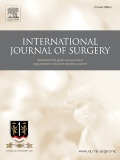
SHOULDER & ELBOW
Interscalene brachial plexus block & IV-inhalation anaesthesia in upper limb fracture
Int J Surg. 2014 Dec;12(12):1484-8.One hundred elderly patients scheduled for upper extremity fracture surgery were randomized to receive either intravenous-inhalation anesthesia or intravenous-inhalation anesthesia with interscalene brachial plexus block (IBPB). This study aimed to investigate whether the use of IBPB with intravenous-inhalation anesthesia would be more effective than isolated intravenous-inhalation anesthesia. Intraoperative complications were documented, vital signs were assessed over 120 minutes after anaesthesia was induced, and postoperative recovery and side effects were assessed over 4-6 weeks. The results of this study indicated that the group which received the combination anesthetic needed less recovery time, suffered lower intraoperative side effects, had lower consumption of propofol and isoflurane posteropatively and no postoperative side effects. Vital signs had negligible difference between groups.
Unlock the full ACE Report
You have access to {0} free articles per month.Click below to unlock and view this {1}
Unlock NowCritical appraisals of the latest, high-impact randomized controlled trials and systematic reviews in orthopaedics
Access to OrthoEvidence podcast content, including collaborations with the Journal of Bone and Joint Surgery, interviews with internationally recognized surgeons, and roundtable discussions on orthopaedic news and topics
Subscription to The Pulse, a twice-weekly evidence-based newsletter designed to help you make better clinical decisions
Exclusive access to original content articles, including in-house systematic reviews, and articles on health research methods and hot orthopaedic topics
Or upgrade today and gain access to all OrthoEvidence content for just $1.99 per week.
Already have an account? Log in


Subscribe to "The Pulse"
Evidence-Based Orthopaedics direct to your inbox.
{0} of {1} free articles
Become an OrthoEvidence Premium Member. Expand your perspective with high-quality evidence.
Upgrade Now












































































